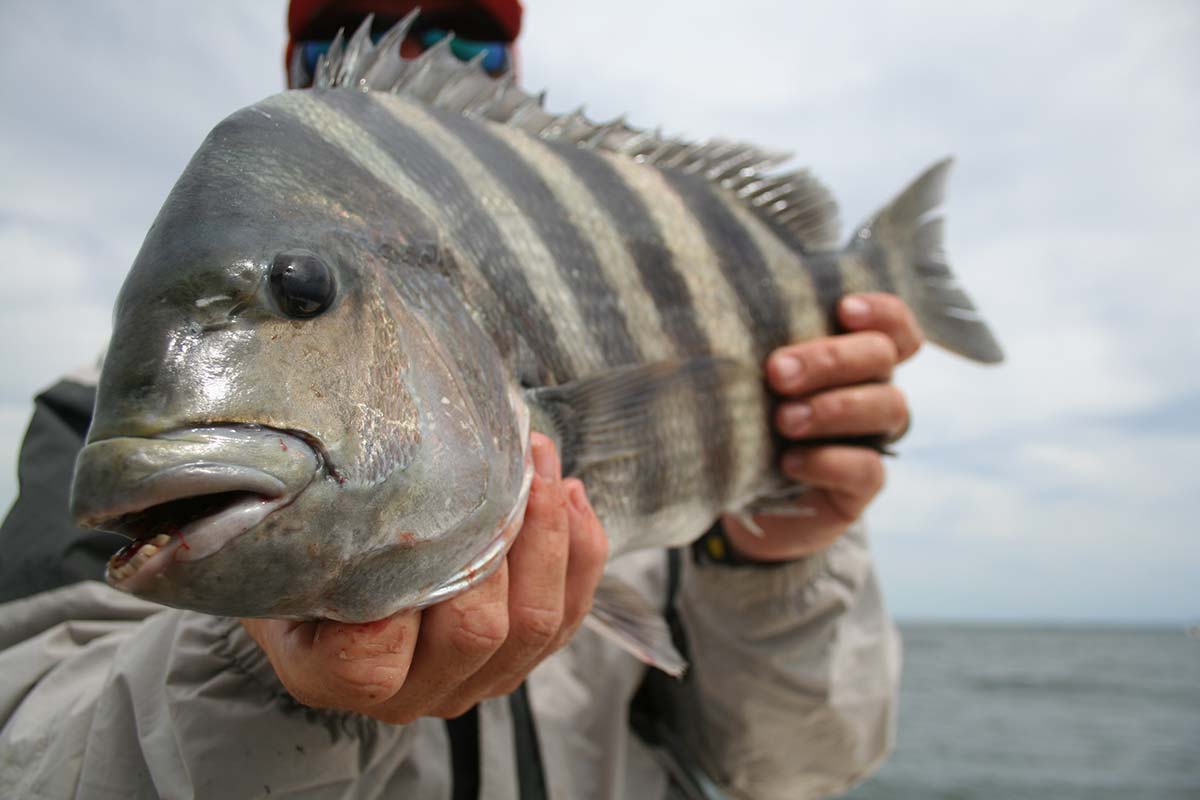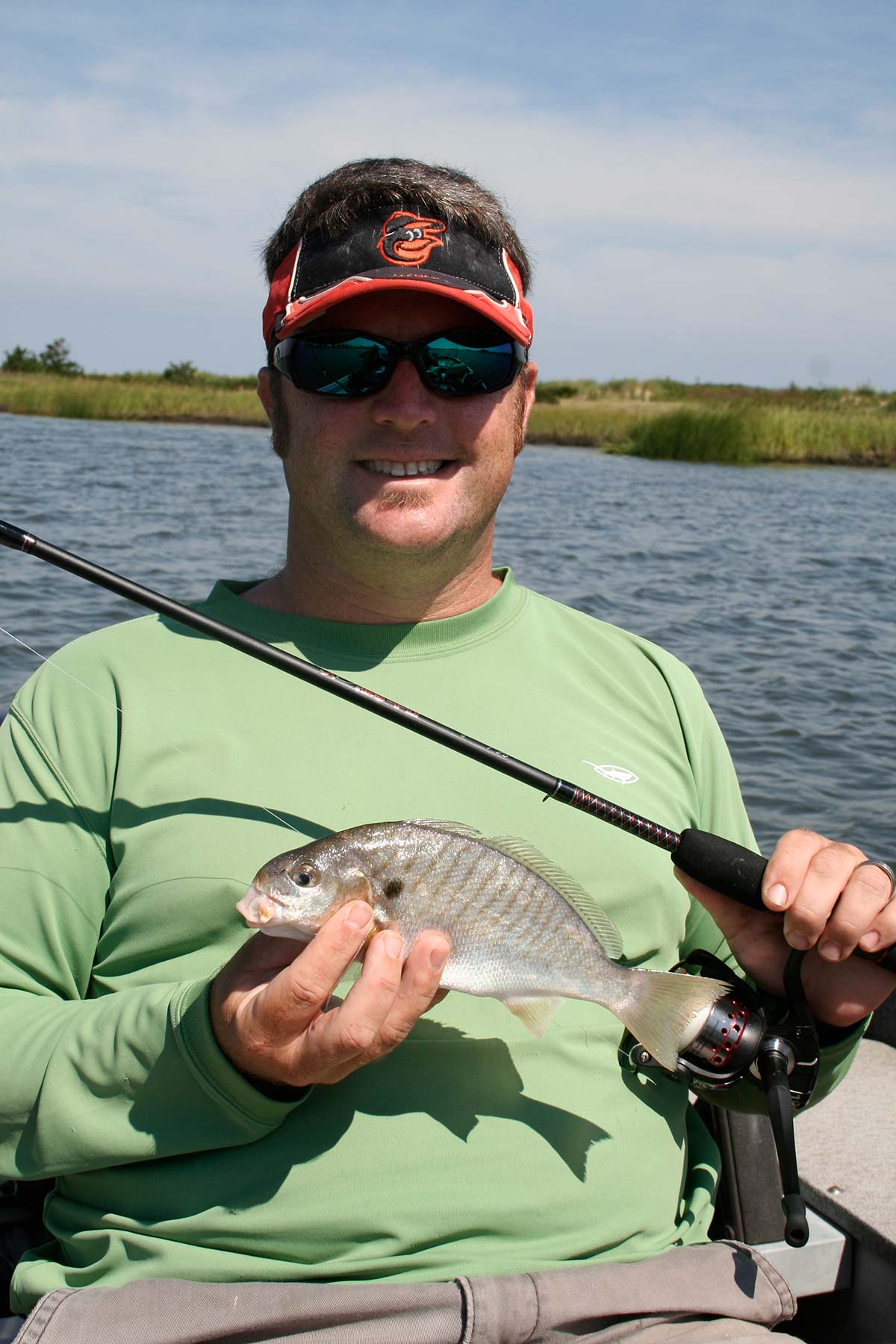
Saltwater “panfish” take center stage during the dog days of summer.
Delaware Bay and I go back a long way. My first memory comes from my grandfather who worked shift work at American Viscose in Marcus Hook, PA. After completing their last night of the night shift he and five of his friends would head down to Mispillion, DE that was actually Slaughter Beach, and head out for a day’s fishing with Captain Green. Their target was porgies.
This was the late 1940s and Delaware Bay held porgies in great numbers. Pop would bring them home in lard cans. If coolers were invented then, he didn’t have one. The fish ended up in the basement next to the stationary tubs where Pop attacked them with a fork, scissors and a knife. The fork removed the scales, the scissors took care of the fins and the knife cut off the head, split open the gut and removed the innards.
My job was to stand on a box and rinse off the body. My grandmother’s job was to dredge the bodies in flour and fry them up in bacon fat. That’s right, everything we ate was cooked in some sort of pig fat. From vegetables in fat back to pie crusts made with lard. Pop only lived into his 80s.
By the time I was old enough to fish in Delaware Bay, the porgies were long gone replaced by croaker. Pop had purchased a 7.5-horsepower Elgin outboard and we would rent a wood boat from a lady at Slaughter Beach; she would drag the boat across the sand like it was a toy. Pop would get in the bow and I would have to push the boat across the shallows until we reached water deep enough to lower the motor, then get in the boat, adjust the choke, the throttle and pray the right prayer that the old Elgin would start on the first pull. Once underway we headed for the Coral Beds and started fishing.

A Weak Return
I don’t remember using anything but squid for bait on a Sears and Roebuck top-bottom rig in those days. We had no SONAR, no GPS, not even a compass. Yet somehow, we managed to catch fish. I would try to line up landmarks on the beach when we hit a school of fish. If we were catching, we would continue drifting until we stopped catching. Then I would run us back to what I hoped was the spot where we started catching and begin the drift all over again.
On one memorable trip, Pop and I were doing really well with the croakers until the current went slack. Then both of us had two savage hits and brought in two of the biggest trout either of us had ever seen. We didn’t weigh them, but guessed they tipped the scales at 5 pounds. That was sometime in the late 1950s.
By the time I got home from the Navy in 1961, the lure of big blues in the surf and rockfish (striped bass) at Indian River Inlet took my attention until the trout explosion began in the late 1960s and early 1970s. After that, all eyes were on weakfish and Delaware Bay was the Weakfish Capitol of the World.
That was then and this is now. I am happy to report that so far in 2022 I have seen more 5-pound trout in my reports than I have seen since the “Good Ol’ Days”. However, if you plan to target trout you are going to have a very slow day, rewarded by one fish in the box. To my way of thinking it is better to go out and target croaker, spot and kingfish, have a great time catching them and come home with a box full of good eating.

Talking Tackle
Since the chances of catching something that is going to test your tackle to its limits is rare, the top consideration is the amount of weight needed to hold bottom. You will be fishing in water up to 70 feet that may require up to 3 or 4 ounces of weight. While catching fish that weigh less than a pound may be fun on a whippy rod, trying to control 4 ounces of weight at 70 feet on one is not. Match the rod to the weight of the sinker, not the size of the fish. I find a Tsunami Trophy II series (TSTIISS 702M) matched to either the EVICT 4000 or SHIELD 4000 will handle all but the heaviest sinkers.
When it comes to line, braid is the way to go. Its thin diameter will require less weight to hold bottom and its less stretch will allow you to feel the slightest touch from the smallest fish at 70 feet. Braid does have less abrasion resistance than mono; for this reason, you should attach a shock leader from the end of your running line. I use 20-pound fluorocarbon that I connect with an Albright knot. The no name knot and the slim beauty will also do the job.
When it comes to rigs, nothing fancy here. Just plain old top-bottom rigs made by just about everyone in the tackle business. Fortunately, the newer versions are not quite a heavy as those Sears and Roebuck models from my past. I like to use circle hooks, but they are not necessary. Plain J hooks will work and a little bright colored float or hair doesn’t hurt.
As for bait, bloodworms, squid, minnows, lugworms, shrimp and sand fleas all find favor with some anglers. Truth told, I have not used bait, except live minnows, for several years. Fishbites in bloodworm, clam or sand flea have worked just fine. I also use Gulp! in nuclear chicken and white for summer flounder.

Lay Of The Land
The bottom of Delaware Bay has changed quite a lot since my grandfather and his buddies fished for porgies in the 1940s. Conk dredgers have plowed up a lot of the bottom and the Delaware Division of Fish and Wildlife has built eight artificial reefs using Delaware’s General Fishing License money. Fish today are found on the reef sites and along such old structure as wrecks and the Inner and Outer walls and the Ice Breakers.
Captain Segull’s Sportfishing Chart of Delaware Bay has all the reef sites and their LAT/LON coordinates listed on the chart. I also went online and typed in Delaware Bay Reef Sites. Up came all the reef sites and the same LAT/LON numbers. However, the Captain Segull’s chart does have many other structures listed that provide good fishing opportunities.
Depending on where you launch from there are reef sites as far north as Site I. It is south of Woodland Beach in Delaware and north of Nantuxent Creek in New Jersey. Site 2 is almost directly east of Port Mahon in Delaware and southwest of Fortescue in New Jersey. The remaining reef sites are reached from Bowers Beach, Slaughters Beach and Lewes in Delaware and Cape May and the Maurice River in New Jersey.
The reef sites contain lots of stuff from concrete pipes to rocks dredged up from the Delaware River channel. I do not suggest baiting up, dropping your rig to the bottom and putting the rod in a holder if you ever want to see that rig again. You have to actually fish to catch these fish. It is important to keep the rod in hand and your finger on the line; you want to feel the bottom and be ready to lift up the sinker when you feel the rig getting into sticky territory. You don’t have to raise it up 20 feet, just enough to get it out of trouble.
Most everyone drifts across the reef sites. Notice I said most. You must be aware of the odd ball that anchors up and don’t drift into him or her.
When you begin catching fish it is a good idea to mark that spot, especially if the SONAR shows good marks. I still use a big Tide bottle on 300-pound mono tied to a window sash that I can drop over. It is easy to see and I can set up my drifts accordingly. Sure, you can also use the man-overboard button (MOB) on your GPS, but I find this clutters up my small screen.
Fishing for kings, spot and croaker is great family fun. You can take out the whole tribe and spend the day baiting hooks, removing fish and generally acting like a parent. You may even have time to make a few drops for flounder who also live on the reef sites. I use a green bucktail with a nuclear chicken Gulp, Fishbites Fight Club, or live minnow.
Back home those small filets make for great tacos. I mix a packet of taco seasoning with lots of corn meal then, after dredging the fish in egg, I drop the filets in to a plastic bag with the seasoning, then slide them out and into hot oil. Cover with cheese and your favorite toppings for a fine meal after a great day on the water.



